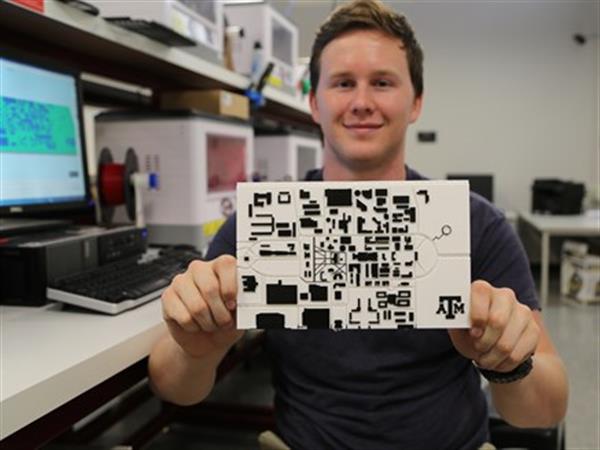Student prints 3D tactile maps of campus for the visually impaired
3D printing technologies help make a difference in the lives of many people across the globe, and in so many ways. Soon, thanks to the ingenuity of a freshman engineering student, the lives of the visually impaired at Texas A&M University will also be changed for the better with the help of 3D printing.

Tyler Wooten, Texas A&M
By Tess, 3ders.org Aug 7, 2016
The student, named Tyler Wooten, has been developing a 3D printed tactile map embossed with braille to help the college’s visually impaired students better understand the university campus and navigate it more easily.
Wooten conceived of the idea for the tactile map while taking a 3D printing course at Texas A&M’s Engineering Innovation Center (EIC) last year. Since then, he has been working closely with a fellow student, Kaitlyn Kellermeyer, to turn his idea into a useful and usable reality.

Tyler Wooten and Kaitlyn Kellermeyer
Kellermeyer, an economics student at Texas A&M, lost eyesight in her left eye as a baby and only recently (in 2014) lost eyesight in her right eye as well, leaving her completely blind. For the past two years, Kelleymeyer has struggled to become accustomed to having no eyesight and has depended on help from her friends to help her get to class and the like. She explains, “I had memories of where everything was relationally. With all the open space on campus, and with the lack of auditory cues, I didn’t realize how hard it would be to get around.”
Kellermeyer has also been a key figure in advocating for new and innovative projects around campus to help the visually impaired, which made her the ideal candidate to work with Wooten on developing his 3D printed tactile maps. Since they’ve teamed up, Kellermeyer has given insight, tested, and provided feedback about how the maps should be designed and feel. According to the visually impaired student, the project has given her more freedom and has made all the difference in helping her to navigate around her university.

Wooten, for his part, designed the 3D campus map using SolidWorks software and 3D printed a number of prototypes using the EIC’s in-house 3D printers. Being relatively new to the technology, Wooten went through some trial and error, but with the help of other students and faculty got into the swing of things relatively easily. As he explained in an interview: “For main campus, I had a picture of the map up on one screen, and I had SolidWorks open on my other screen and I was just eyeballing it, drawing all of the buildings. Enough people had heard about it that they taught me how to do it better. Now I can take a screenshot of the map, put it in SolidWorks and just trace the buildings.”
In the end, the 3D printed tactile maps of campus were printed using PLA and are only 1/4 of an inch thick, making them easy to carry around. To account for the size of the campus, Wooten has separated the whole map into different sections, each measuring 5 x 9 inches, which can be easily assembled by sliding them together. Wooten, who invested his own money for the 3D printing materials, said that each section took roughly 5 hours to print.

Of course, the project is still in development as is being constantly improved by Wooten and Kellermeyer. For instance, according to the students, the roads on the tactile map are going to be widened, the buildings have been shortened, and the braille has been improved and corrected. The braille, which is printed on a number of the University’s main buildings, is meant to identify main campus spots and help orient the map’s users.
Tracey Foreman, assistant director of disability services at Texas A&M, is optimistic about the project. She said, “Having access to a tactile map allows a visually impaired individual to better understand the scale, size and proximity that cannot always be gathered solely by walking around or having something verbally described to the individual.”
As they keep working on the innovative 3D printed tactile maps for Texas A&M, Wooten is also starting to design tactile maps for other campuses, including the Westbrook Intermediate School in League City, Texas, and the Brazos Valley Center for Independent Living in Bryan, Texas, where a number of disabled people reside. Here at 3Ders, we can’t wait to see what else Wooten, who has managed to help the visually impaired people in his community in only his freshman year, comes up with next!
Source 3ders.org
